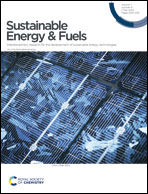Primary graphitization of multi-functional dihydropyridine, a novel method for reconstructing a TiO2 surface to obtain high photocatalytic activity for hydrogen peroxide synthesis†
Abstract
As a green and sustainable energy technology, converting solar energy into hydrogen peroxide (H2O2) chemical energy has become one of the key research fields of photocatalysis. It has been reported that TiO2 has reached an excellent H2O2 productivity of 3.3 mM h−1, and, therefore, there is value in using it for further research. Herein, a novel method for repairing and improving the surface of TiO2 was developed using small organic molecules that can enter the nanopores of TiO2 to form C, N, and O co-doped graphite-like hybrid structures. Thus, efficiently and conveniently, a multifunctional dihydropyridine with an electron-donating hydroxyl substituent successfully conducted thermally induced intermolecular condensation and subsequent in situ graphitization, resulting in efficient regulation of surficial properties. The results show that hybrid species enhanced the separation and transmission of photogenerated charges, reduced the photocatalytic effect for the decomposition of H2O2, and provided an effective channel for photocatalytic H2O2 synthesis. Under xenon lamp illumination, an initial rate of 10.22 mmol (h g)−1 H2O2 was obtained, which exceeded that for all previously reported catalysts. In addition, ACMD successfully increased the light utilization efficiency of nano-TiO2, with an apparent quantum efficiency (AQE) of 24.5% at 365 ± 5 nm and a solar-to-chemical conversion (SCC) efficiency of 2.18% under irradiation above 300 nm. Its visible light performance was significantly improved to afford 3.12 mmol (h g)−1 H2O2 with an SCC of 1.17% under irradiation greater than 420 nm. Because of the diversity of such organic molecules, this method provides researchers with many opportunities to further optimize hybrid species on the surface of TiO2, and, therefore, it is significant for the development of photocatalysts.



 Please wait while we load your content...
Please wait while we load your content...